Rhythm, Repetition, Contrast, And Movement In Design
Rhythm, repetition, and contrast are important interior design concepts every home decorator should know about and use. These concepts are so easy to learn and will help you be a more confident decorator!
Every home decorator should know about and use rhythm in interior design. This is an easy principle to learn and apply as you decorate your home. It is a tried and true concept that will make a big difference in the way you decorate and the way your home will look! Rhythm just might be the secret to your decorating success!
Rhythm in interior design is a fundamental concept every home decorator should understand and apply. It’s an easy principle to learn and use, and it can transform the look and feel of your home. By mastering rhythm, you’ll create a cohesive and visually appealing space. Incorporating this time-tested design principle into your home just might be the key to your decorating success!
Welcome To Decorating School
Decorating School is a free resource for the everyday home decorator who wants to create a comfortable, beautiful home that meets the needs of their unique family. Every decorating post is filled with tried-and-true interior design tips and advice, broken down into easy, repeatable, and actionable steps.
When we talk about rhythm, we should also talk about repetition, contrast, and movement. Think of rhythm as the umbrella under which repetition, contrast, and movement live. All these things work together to create beauty in the eye of the beholder.
My Decorating Mission
It is my passion to break down design concepts into easy-to-understand and doable processes you can use in your home. The concept of rhythm is really easy! You are probably decorating using without even knowing it! The goal, however, is to do it purposefully!

What People Are Saying About This Post
Thank you so much for this. It has opened my eyes and brain. it all makes so much sense the way you broke it down.
Rose, a StoneGable Reader
Rhythm is one of the easier concepts once you know what it is. Let’s see how to use rhythm in our homes!
What Is Rhythm In Interior Design
In this Decorating Series, we frequently discuss the fascinating connection between our eyes and brains and how this relationship influences our perception of beauty.
It’s important to consider this eye-brain connection to fully grasp the concept of rhythm in interior design and its crucial role in creating a beautiful home. Imagine rhythm as the way our eyes naturally move through a room. Did you know that our brains constantly strive to make sense of what we see, and rhythm is a key aspect of this process?
Our brains thrive on organization. We find a room attractive when our eyes can seamlessly move from one element to another, noticing patterns and repetitions. Rhythm in interior design is all about the organized movement of our eyes around a space. Our brains identify and appreciate repeated elements, such as consistent colors, shapes, or items, which create a sense of order and harmony.
So, here’s a practical definition of rhythm in interior design: it is the deliberate repetition of visual elements to guide our eyes smoothly through a space, creating an organized and aesthetically pleasing environment.
So here’s a good working definition of rhythm in interior design…
What Is Rhythm?
Rhythm is the idea of creating organized movement around the room by repeating elements in a space.
Our eyes dart around a room at lightning speed, moving from one thing to another. When they encounter similar objects, shapes, and colors, a sense of rhythm is established, allowing them to navigate the space with ease.
There are several ways to create rhythm in a room, but one of the easiest and most effective methods is through repetition. Repeating patterns, colors, textures, or shapes can unify a room, guiding the eye smoothly from one point to another.
The goal of rhythm is to help our eyes move throughout a room by strategically repeating and contrasting elements. By thoughtfully incorporating rhythm into your design, you create a cohesive and inviting environment where each element interacts with the others, making your home both visually interesting and beautifully organized.
Why Is Repetition So Important

When we incorporate repeated items in a room, our eyes subconsciously seek out these recurring features, enabling them to navigate the space with ease. This seamless visual journey helps our brain make sense of the room, resulting in what we perceive as attractive and welcoming.
Repetition can manifest in various forms, like using the same colors, patterns, textures, or shapes. This repetition creates a visual thread that ties the room together, allowing the eye to move smoothly from one element to the next.
The beauty of repetition lies in its ability to bring order and balance to a room. It provides a sense of predictability that our brains find comforting and aesthetically pleasing. By thoughtfully repeating elements, you can create a space that feels well-organized and cohesive, making it more enjoyable to live in.
Repeating Color In A Room
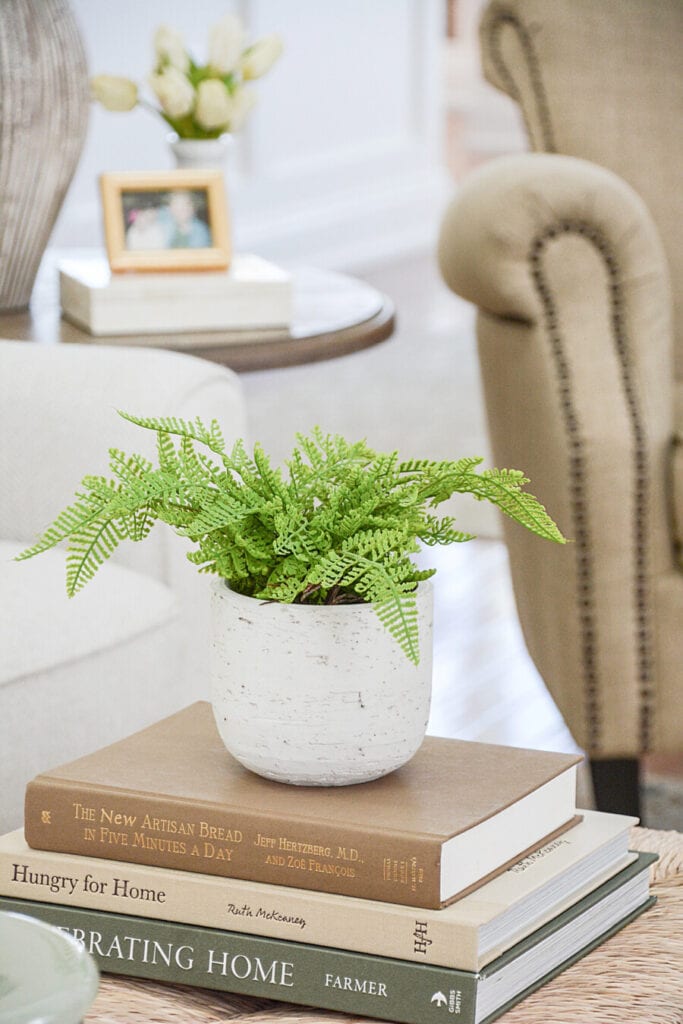
One of the simplest ways to add beauty to a room is through the rhythm of color. Repeating colors within a room or throughout your home creates a cohesive look. And there’s nothing more attractive than a unified color story!
Establishing a color palette for a room/ your entire home is a wise idea because the repetition of color allows our eyes to move effortlessly around our spaces. This concept is known as flowing rhythm.
How to Choose a Color Palette for Your Home is an easy-to-understand guide to creating the perfect color scheme for your living spaces.
Remember to strive to distribute color around the room and not all in one place. In the image above the chair in the background works with the brown book on the coffee table! And on the other side of the room, the trim on the pillows is the same color, too!
A Pop Of Color

Have you ever wondered why so many decorators emphasize a pop of color? The answer is simple: this design concept works! Using a pop of color in a room energizes it and adds visual interest. However, a pop of color should never stand alone!
Think of the nursery rhyme “The Farmer in the Dell,” where each character follows the next, but in the end, the cheese stands alone. Don’t let your pop of color be the cheese!
A pop of color is only effective if it appears in multiple places within a room. It can vary in tints (lighter versions) and shades (darker versions), but it should be present in at least three distinct spots. This creates a cohesive and engaging look. A pop of color is easy to incorporate into any room in your home, even in a neutral space.
An Example Of A Pop Of Color
Even though our living room is very neutral, it has enough repeated colors to make it interesting. A pop of color often means using the green in plants as a pretty pop! Or the color in a lampshade. Just remember to repeat it in a few strategic places around the room.
Other Things to Repeat
Color is not the only item that can be repeated around the room. Here are a few more…
Elements to Repeat in a Room to Add Rhythm
- Patterns – Use similar patterns in textiles and wallpapers.
- Textures – Repeat textures like woven fabrics, wood grains, or metallic finishes.
- Shapes – Incorporate consistent shapes in furniture, decor, and architectural elements.
- Materials—Strategically Place the same materials (like glass, wood, or metal) around a room.
- Lines – Repeat horizontal, vertical, or diagonal lines.
- Furniture Styles – Maintain a consistent furniture style throughout the room.
- Lighting Fixtures – Use similar styles or shapes in lighting fixtures.
- Artwork Themes – Repeat themes or colors in artwork.
- Plants and Greenery – Use similar types of plants or planters.
- Decorative Objects – Repeat the use of specific decorative objects, such as vases or sculptures.
- Rugs and Carpets – Use similar patterns or colors in rugs and carpets.
- Trim and Molding – Repeat trim and molding styles on walls, doors, and windows.
- Curtains and Drapes – Use the same fabric or style in window treatments.
- Pillows and Cushions – Repeat fabric patterns or colors in pillows and cushions.
Contrast And Rhythm In Decorating

Let’s now explore another important component of rhythm in interior design: contrast.
While repeated elements help our eyes easily move around a room, too much repetition can become monotonous. Our eyes enjoy repeated patterns, but they can quickly grow bored without variety. To keep things exciting, it’s essential to introduce contrast into your space.
Contrast creates a sense of tension, which adds visual interest and keeps the eye engaged. It’s important to avoid clustering too many similar items together in one area. Repetition is beneficial, but when the same elements are concentrated in a single spot, it can feel overwhelming and dull.
Instead, distribute repeated elements throughout the room, and intersperse them with contrasting things. Doing this will keep a room visually stimulating.
The key is to think of contrast as a mix-and-match strategy that adds depth and character to your space.
By thoughtfully incorporating contrast alongside repetition, you create a beautifully interesting environment. This balance between consistency and variety is what makes a room truly captivating.
Examples Of Contrast
A round table with a round lamp on it and a round box and round knobs on the drawer on the table can look a bit ho-hum! Add a bit of contrast by replacing the box with a square one. A little contrast is a good thing!
Repeat elements and then mix in something a bit different. And repeat that difference at least once or, better yet, three times around the room! Remember, there is magic in groups of three.
But don’t go overboard. Yes, our eyes love contrast, but too much contrast confuses our eyes, and our brain will perceive it as cacophony!
The Bottom Line

Rhythm plays a crucial role in creating beauty within a space. The good news is that most people naturally incorporate rhythm into their decorating without even realizing it. Our eyes are hardwired to recognize repetition, appreciate movement, and enjoy contrast in small doses.
By becoming aware of this element of interior design, we can make more intentional choices about what we include in a room. This awareness allows us to create a greater sense of harmony in our homes, making our spaces more aesthetically pleasing and cohesive.

FAQs about cheesecloth
More Priciples Of Design To Know
Interior designers know tricks of the trade that are tried and true and work to create unity and cohesiveness and beauty in a room. We can learn these easy concepts too and use them in our homes!
Decorating your home in your own style does not have to be hard! Learn and use interior design concepts like rhythm and repetition to help you be a confident home decorator!


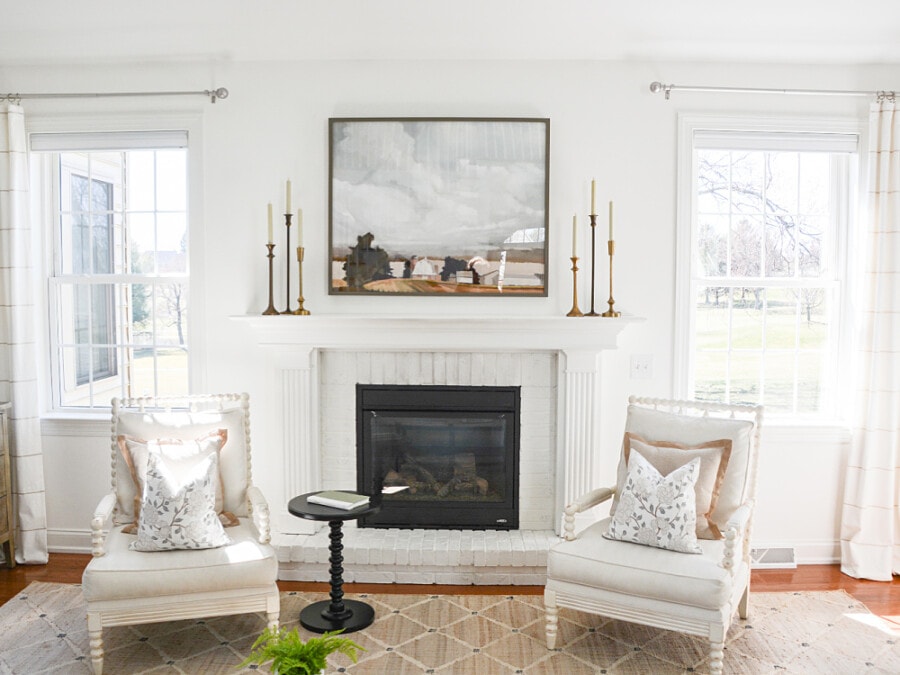


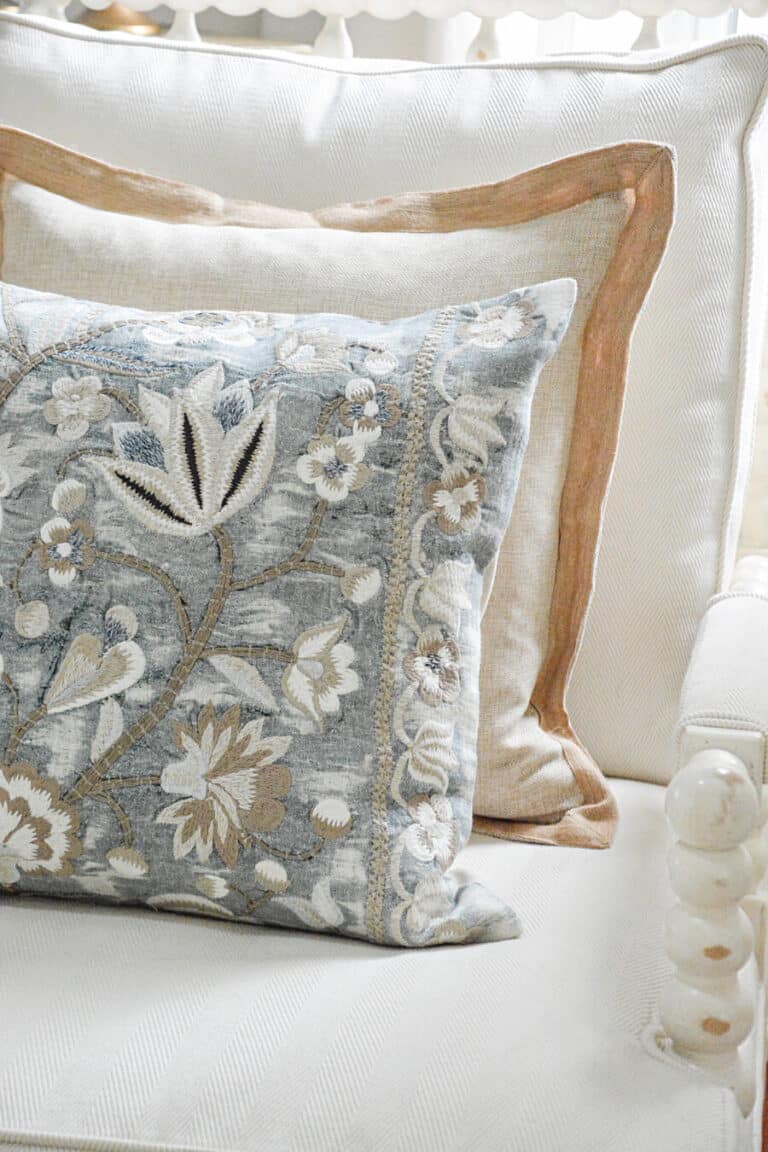

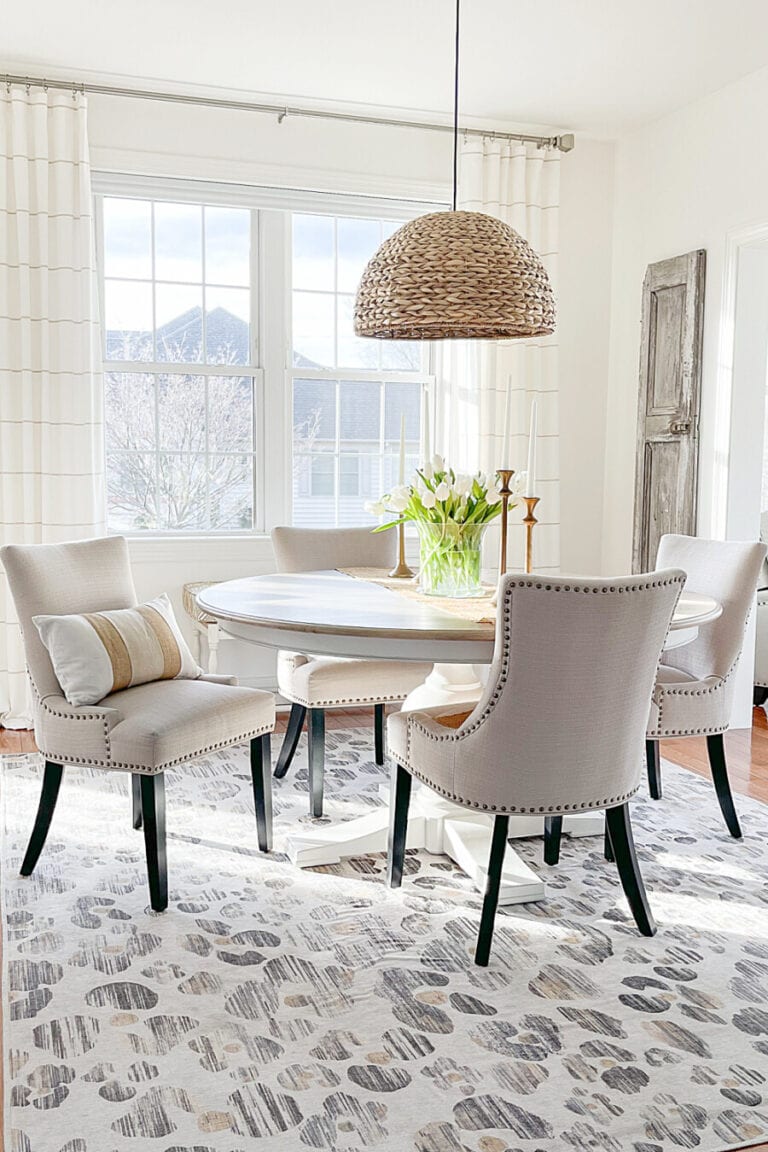
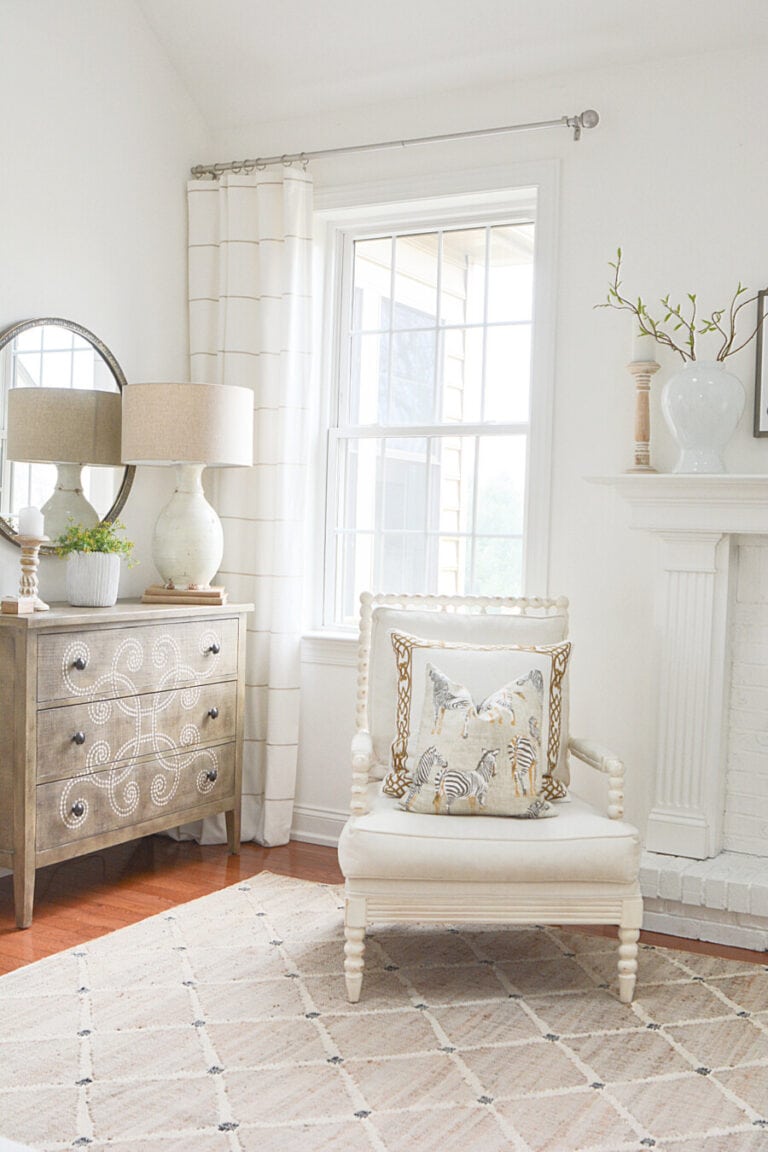
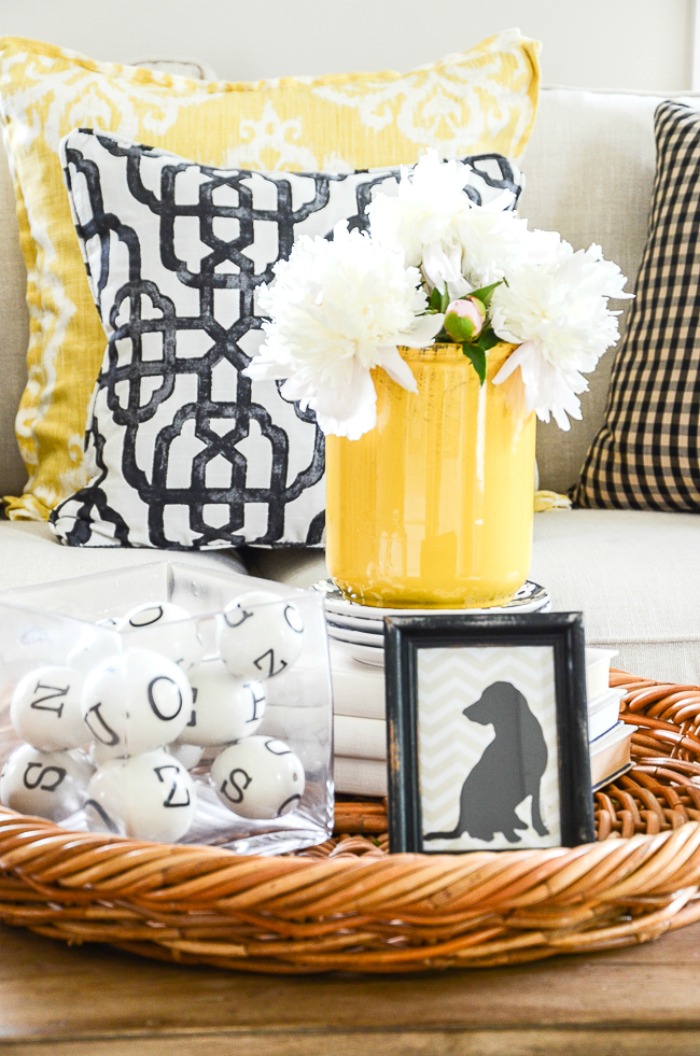
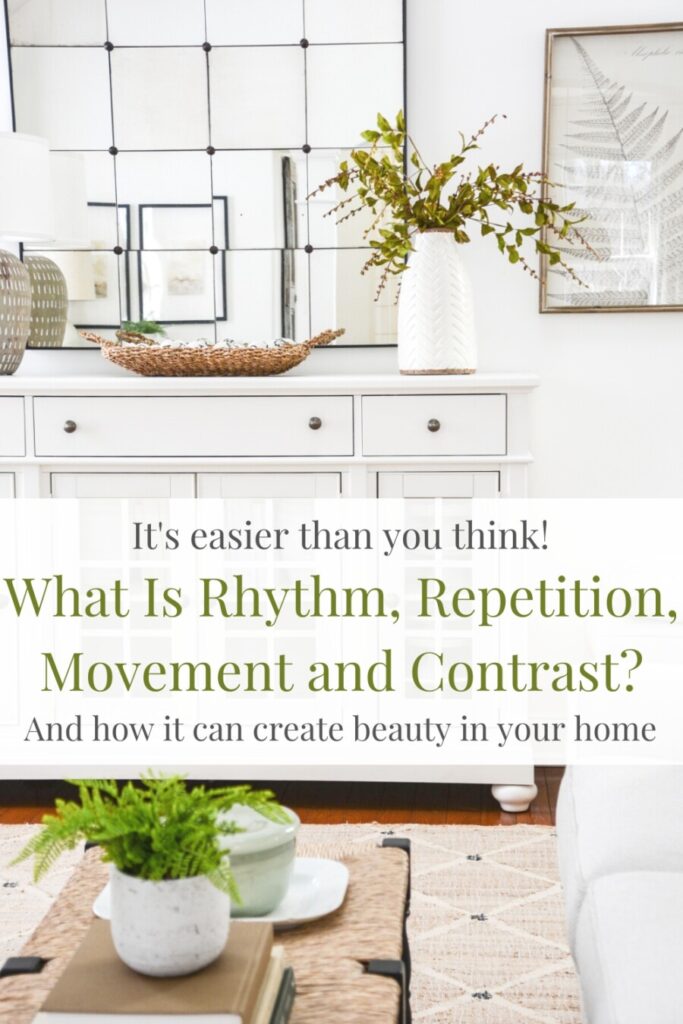
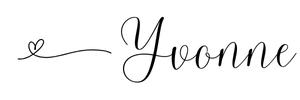
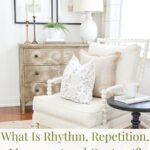
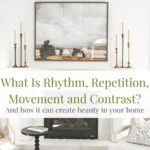

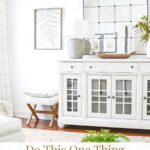
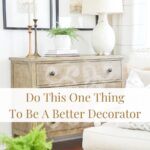
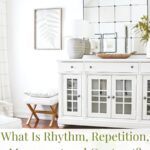
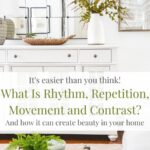
i just love your baskets/trays. I look and look for the exact ones and dont seem to have any luck.
This was a great article. Will read over and over……
Hi Tracey! I love writing about interior design. As I have said I am passionate about sharing with my readers, who love to decorate, these designer concepts. The will make a huge difference in the way we decorate!
Hi Yvonne.
About the curtains…..
I usually appreciate your designs and ideas but not this time. I do not wish to offend. I am not a fan of those drapes . I had to listen to my gut…. ok… it feels like the curtains have been a “bad boy” and been relegated to being stuck in a corner. They do not breathe. It feels like they are choking. The curtains are fine. The rods are so short and stocky which also adds to the heaviness. So change the rods and have them go to other end of the window. Do this for both windows. It would have been nice to see what the windows look like when you lower the shades…..
I ever knew it was called rhythm in decorating world but I know I like to echo shapes and colors in my rooms. When ever a decor doesn’t seem just right to my eye this always seems to do the trick.
Have a great 4th even though quieter this year and as always thanks for all you do to help us make our homes a good place to spend so much time in.
Thanks, Kathy! We are spending time with immediate family! Yes, it will be a lot quieter, but we will be celebrating! My family has served our country and I am a Air Force brat! We are so proud to live in this blessed country!
I love your posts…I learn so much. One thing I don’t believe I have seen is some advice on personal photos. Do you have ideas on creative ways to display? I’d love to make a photo wall, but looking for a way to do this to make it look good.
Hi Barb, what a wonderful idea! I have my personal photos in my study and bedroom. Instead of a photo wall I have them en mass on a couple of shelves. Much easier to switch out or add more photos to!
Great post as always. I always learn so much.
I learn from you too!
I love your blog!! Thank you for sharing all your knowledge. Where did you get the lamp in this post?
Hi Kris, many of the lamps came from Pottery Barn and the one on the chest is from Wayfair.
I learned alot and pinned. Thanks for all the great advice and info! Your home is always pleasing to the eye!
THanks, Deb!
Thank you for your post and your website! I always love reading your blog! Could you tell me where you purchased your light colored chairs with nailhead trim pictured in the image above with the woven pendant? Many thanks!
Hi Jenn here is the link for our dining room chairs:https://www.birchlane.com/kitchen-dining/pdp/dremil-arm-chair-rdba1878.html
Thank you so much! They are beautiful!
The repeated elements you taught me today are very helpful! I never really thought about that in decorating a room.
Where did you purchase the metal cage lamp on the buffet?
Julie
Hi Julie, I’m so happy this post helped. The lamp came from the Pottery Barn a few years ago.
Wow, what great information. I will never look at my home the same. Thank you so much. Now I need to apply these principles to my home.
I love this design series – I’m reviewing them all now. Well done!
By which I mean revisiting…
Thank you Diane!
This is so helpful, thank you for sharing all of your design wisdom. May I ask where you purchased the mirrors over the chest, they are so unique!
Thank you,
Vicki
Hi Vicki, that mirror is so old! I found it at HomeGoods years ago. Check Wayfair for something similar.
Oh ….I am so happy that you are here to help us all decorate our homes… I look for your post every day! My vignettes now have rhythm!
Good for you Candice!
Thank you so much for this it has opened my eyes and brain. it all makes so much sense the way you broke it down.
Hi Rose, this just thrills me! Happy Decorating.
Love your posts! Rhythm and symmetry makes so much sense. I often use your techniques in my own decorating. Can you tell me the plant you show on your dining room table?
Debbie
Hi There
I’ve been enjoying your site every day for awhile now. Thanks soooooo much. I’m going to be doing some major work in the spring and you’re the star of the show.
Who knew! I’ve been decorating this way for years but didn’t know they were design principles! Thank you for sharing your knowledge!
I’ve read others comments and well… I love the drapes and the way you’ve hung them! In fact, we’re doing a major renovation to our master suite this coming fall and our bed will be between 2 windows… I plan on using my drapery in exactly the same way! I think it frames the focal point beautifully.. in your case.. the fireplace… in my case the bed! Thanks for the wonderful inspiration!
You are so welcome Marcella!
Great article, Yvonne! I learned a lot through your examples, and it has me thinking about changes I want to make to our living room. Thanks for sharing! Hugs!
So glad this got you thinking, Chrissy!
Sooooo informative and helpful! Your exquisite taste inspires me to try new things!
Love your color choices… can you share where you purchased your rug??? I love it!
Thank you, Mary! The rug is so beautiful in real life and beautifully made. See it here:https://rstyle.me/+hu3rWsVZtbqK_gl1j73K8w
Wow. I hav been following u fr quite a while and I hav tried to emulate your style. It’s the epitome of everything I hope fr in my home. Your use of color, texture, & content tops all others that come across my feed. Please know u r appreciated!
Oh, Debra! Thank you for the most lovely compliment. I post about my home and decorating techniques to help others, and your comment make me so happy that StoneGable is helping you!
I love your sheer drapes. Would you please tell me where you got them?
Thank you!
Hi Mary, these drapes are such nice quality. Here you go:https://rstyle.me/+dDnQ1V1rkqiZ2YxPpwDTcw
I’ve got rhythm, I’ve got music, I’ve got Yvonne, who could ask for anything more?? Thank you for the primer Mrs. Yvonne. Very helpful.
I giggled out loud! So cute.I hope this helped you.